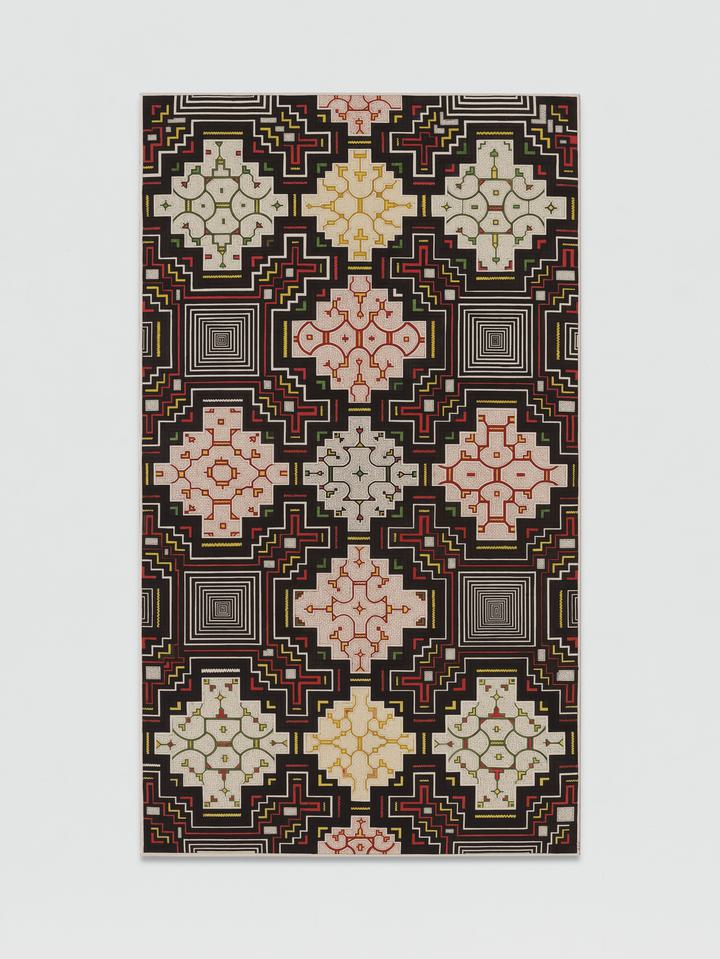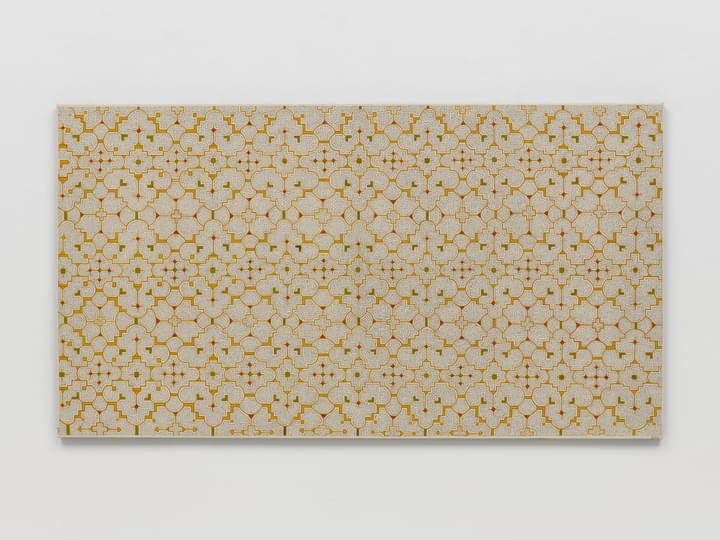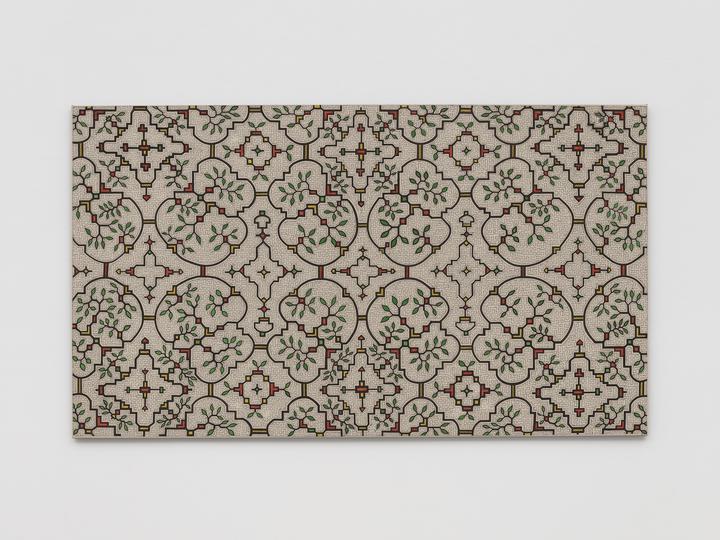Associated with Shipibo notions of ‘design’, Kené shares etymological links to the verb kéenti, meaning to love or care for – an expression reflective of the depth to which Kené runs through the reciprocal values, lifeways and spiritual ethics of the Shipibo-Konibo people. The practice is believed to trace its origins to the ancient ‘Incas’ of the Shipibo, divine mythological figures who received Kené through observations of nature, perceiving the fluidity of forms and codified patterning intrinsic to the native flora, fauna and spiritual world. This spiritual dimension is introduced through shaman-led rituals where the ingestion of psychoactive ingredients including Kené Wáste and ayahuasca serve as the point of contact between the material world and invisible life forces, expanding individual consciousness and inducing visionary experiences. Kené
interprets these visions and the organic patterning found in nature through maze-like configurations, mapping the Amazonian rivers, summoning the serpentine energy of the cosmic anaconda, Ronín, evoking the musical sequences of the ayahuasca ceremonies and giving representational form to the spiritual world.
Born in 1950 in the native community of Tambomayo within the Peruvian Amazon, Flores was given the Shipibo birth name Soi Biri, meaning ‘well done’ or ‘precisely drawn’. At the age of 14, she initiated her apprenticeship in the art of Kené under the guidance of her mother, who instilled in Flores the practice known to the Shipibo as joni-ati or ‘person making’. During this formative period, she recalls taking walks with her mother, who would gather ipobekené leaves and delicately press them onto her eyelids so that she ‘could better receive the designs’.
Flores’s Kené designs are shaped by two essential facets: Menin, representing the technical mastery of the craft, and Shinan, embodying the visionary aspect. While the first can be acquired through learning, the second is innate. Flores first realised she possessed shinan as a child, spending hours under the mosquito net where the gridded meshwork would transform before her eyes into intricate black and white configurations. Upon closing her eyes, the colours of these designs would reveal themselves to her. Over time, her skill has evolved to a point where, upon sitting in front of the canvas, the gift of shinai picotai takes over – ‘the hand goes by itself and inspiration emerges.’
The Shipibo-Konibo believe that Kené is revealed exclusively to women, inherited and passed down through matrilineal succession. Drawn in free form, Flores’s works are precisely rendered without the aid of preparatory sketches or digital processes, guiding our gaze through expertly winding rhythms and purposeful trajectories of strokes that give rise to finer traceries (kétana) and precisely formed motifs (weshé). Reflecting the transformative properties of design, the ordered and equilibrated motifs of Kené hold significant value among the Shipibo for their curative properties. According to Shipibo belief, ill-health arises from a disharmony of aesthetics, necessitating the unravelling of disorderly elements with orderly ones. This visual potency aligns with kikin, a Shipibo concept that embodies ethics and synesthetic aesthetics rooted in sensory experience – an accord of olfactory, visual, aural and vestibular elements, which serves to restore inner peace while also functioning as a visual manifesto for Indigenous principles, advocating for wellbeing and a reciprocal way of life.
Flores procures the materials for her Kené designs from her immediate environment, creating dyes from native trees and botanicals, which are then applied to tucuyo, a canvas made from wild cotton. The bark from three trees, two of which are from the river delta and the other from the highlands, is blended to produce the black peshtin. Reduced to a brown tincture, the dye is applied and then washed off the canvas with a clay solution which transforms and sets the colour to black. Flores previously cultivated a particular light brown from the bark of the jene joshón tree, which grew by a small stream behind her house. Due to pollution, the stream eventually dried up and the jene joshón disappeared, compelling Flores to create her Kené without this shade of brown. Additional polychrome dyes are prepared from autochthonous flora – the leaves of the Amí yield purple, the fruit of the Achiote produces red, the bark of the Yacush apana creates black and the root of the Guisdor results in yellow. Through this process, Kené establishes a direct connection with the land of the Shipibo-Konibo, becoming a conduit for the enduring spirit of its flora and trees.
In 1976, Flores co-founded Maroti Shobo in the native community of Paohyan, marking the establishment of the first women’s co-operative among the Shipibo people. The organisation, still active today, anticipated other co-operative initiatives which are now integral to the Shipibo socioeconomic vision for an Indigenous future. Through collaboration with the Shipibo Conibo Center, Flores’s work funds environmental activism and Indigenous resistance in the Peruvian Amazon, based on an agreement of reciprocity and an understanding of kinship that extends beyond the human to the wider environment.
Continuing tradition, Flores now collaborates with her daughters in a process that allows them to engage in each other’s work. Whilst Flores oversees the harvesting of materials, and the creation of the longer, unbroken lines of peshtin, her daughters assist with ketana, the secondary lines drawn in parallel to the peshtin.
Sara Flores (b.1950) lives and works in Peru, and is part of the Shipibo-Konibo, an Indigenous people spread out alongside the Ucayali River. Selected solo exhibitions include Museo de Arte de Lima, Peru (2025); White Cube Paris (2023); CLEARING, New York (2023 and 2022); White Cube Online (2021); and Outsider Art Fair, New York (2020). Selected group exhibitions include Sainsbury Centre, Norwich, UK (2024); Musée du Quai Branly-Jacques Chirac, Paris (2023); Para Site, Hong Kong (2023); El Museo del Barrio, New York (2023); Museum Voorlinden, Wassenaar, Netherlands (2023); Inca Garcilaso Cultural Center of the Ministry of Foreign Affairs of Peru and MAC Museum of Contemporary Art of Lima, Peru (2022); Sala Luis Miró Quesada Garland, Miraflores, Lima (2021); Drawing Lab, Centre d’art privé dédié au dessin contemporain, Paris (2020); and Austrian Cultural Forum, New York (2018).
























